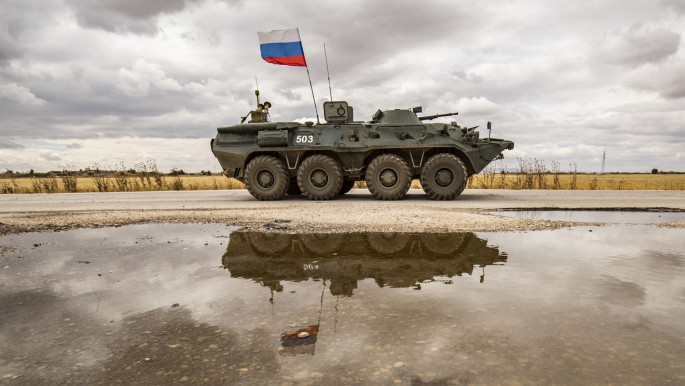Russia and China vie for influence in US-dominated Middle East arms market
However, there are numerous indicators in recent years that these states are increasingly doing just that.
General Kenneth F. McKenzie, head of the United States Central Command (CENTCOM), claimed on 10 June that US arms sales to various Middle East states helps prevent those countries from relying more on Russia and China for their hardware.
US arms sales, he said, "assure our partners in the region that we're going to be around, that we're going to be dependable partners."
"We don't want them turning to Russia, [we] don't want them turning to China to buy those systems," he added. "We will also have a measure of control over how those systems are used."
The United States remains the largest arms exporter by far in the world, with 52 percent of its arms exports going to the Middle East. In the 2014-18 period alone its wealthy client Saudi Arabia became the world's largest arms importer, mostly importing advanced American-built military hardware.
 |
The United States remains the largest arms exporter by far in the world, with 52 percent of its arms exports going to the Middle East |  |
While Russia and China make much more modest arms sales in the region the foothold they have attained in the arms market in recent years is far from insignificant.
Russia has made significant inroads in selling sophisticated weapons to both Egypt and Turkey, traditional US clients for many decades now. It has sold a fleet of MiG-29 fighters, Ka-52 attack helicopters and S-300 air defence missiles to the former and advanced S-400 air defence missiles to the latter in recent years.
In 2017, US President Donald Trump signed the Countering American Adversaries Through Sanctions Act (CAATSA) legislation into law. CAATSA seeks to deter countries from making significant transactions for the purchase of Russian military hardware.
 |
|
| Read more: Warm waters at last: Russia's expanding military footprint in the Middle East |
When NATO member Turkey ordered S-400s in a $2.5 billion deal, it became eligible for CAATSA sanctions. And while it was removed from the F-35 Joint Strike Fighter program in the summer of 2019, upon taking delivery of the first components of S-400s, it hasn't become subject to CAATSA sanctions yet given the Trump administration's reluctance to impose them.
US Senator Lindsey Graham urged Turkey not to activate the missile system to avoid sanctions and reaching a point of no return on the contentious issue. Ankara refused, invariably stressing that it purchased the missiles to deploy them.
While Turkey had originally scheduled its S-400 activation for this April it has not yet done so. Ankara insists this is simply because of its preoccupation with the Covid-19 pandemic, insisting that it will still activate the system despite US opposition.
Far from backing down on its decision to purchase S-400s, Turkey is eager to order a second batch of the missiles in the near future. Its willingness to double down shows how little the threat of CAATSA sanctions has deterred a major US ally and fellow NATO member from buying advanced Russian military hardware.
Egypt is in talks to buy a fleet of advanced Su-35 fighter jets from Russia in a $2 billion deal. The US has warned Cairo that it too could become subjected to CAATSA sanctions too if it pushes forward. As with the Turkish S-400 case, we have yet to see if Washington will actually slap sanctions on Egypt. China has gotten a smaller foothold into the lucrative Middle East arms market by selling weapons the US presently refuses to.
 |
While Russia and China make much more modest arms sales in the region, the foothold they have attained in the arms market in recent years is far from insignificant |  |
The US, Russia, and most European countries are signatories of the Missile Technology Control Regime (MTCR) that opposes the proliferation of most ballistic missiles and drones. Beijing never signed the MTCR and thus had no compunction in helping Turkey develop its ballistic missile program and selling armed drones to Iraq, Jordan, and the United Arab Emirates. The latter's Chinese-made Wing Loong II drones have been used extensively in the conflicts in Libya and Yemen.
Now, the Trump administration plans to "reinterpret" the MTCR which could potentially reverse Washington's ban on the sale of armed drones which, according to Reuters, "open up sales of armed US drones to less stable governments such as Jordan and the United Arab Emirates that in the past have been forbidden from buying them."
"Sidestepping the accord would allow US defence contractors General Atomics Aeronautical Systems Inc and Northrop Grumman Corp to break into new markets currently dominated by less sophisticated offerings from China and Israel, which do not participate in the MTCR," the report noted.
 |
|
| Read more: Turkey, US sanctions and the looming S-400 showdown |
Jordan has sought to sell off its fleet of Chinese-made CH-4B "Rainbow" drones after operating them for just over two years. Amman reportedly was "not happy with the aircraft's performance and was looking to retire them." That incident strongly suggests that if the US is in the market for selling drones, many Middle East states would readily opt to buy American drones over Chinese ones.
Saudi Arabia's only ballistic missiles were procured from China. It secretly bought antiquated DF-3A missiles in the late 1980s. Then in 2007 it covertly purchased more accurate and advanced DF-21s. These missiles were put on display for the first time in 2014. Neighbouring Qatar also purchased short-range Chinese-made SY-400 ballistic missiles, which the Qatari military paraded for the first time back in 2017.
Unlike the US, Russia and China also have less qualms about how their exported hardware is actually used. While Washington implements end use agreements on the hardware it sells, Beijing and Moscow have more of a 'no strings attached' approach.
One demonstrable case in point was a recent comment made by Russia's ambassador to Turkey Alexei Yerhov on the Turkish S-400s.
 |
Unlike the US, Russia and China have less qualms about how their exported hardware is actually used |  |
"Let's say I'm a car distributer and you wanted to buy a vehicle from me. We got the money and sold the vehicle to you. The vehicle is yours. Whether you go to the beach, carry potatoes or install a machine gun on it, join a war, it's your natural right to keep it in the garage," Yerhov told CNN Turk.
For similar reasons, Iraq is once again reverting to its roots as a significant importer of Russian arms. Its experience operating US-built F-16 Fighting Falcons and M1A1 Abrams main battle tanks may already have convinced Baghdad that buying arms from Russia or China with no strings attached would be much more advantageous.
F-16s are by far the most advanced jets Iraq has operated in the post-2003 era. The 36 fighters were delivered during the war against Islamic State and did bomb the group, albeit not nearly as much as Russian-built An-32s transport planes Iraq used as bombers or Russian and Iranian-supplied Su-25 Frogfoot attack planes. Also, the F-16s need a lot more maintenance and spare parts, neither of which they have apparently gotten this year.
 |
|
| Read more: Covid-19 diplomacy: Mapping China's Health Silk Road in the Middle East |
During the dangerous increase in Iran-US tensions in Iraq in January, US personnel were evacuated from Iraq's Balad Airbase. Since then, Iraq's F-16 fleet has become grounded and can no longer sustain bi-weekly patrols over Iraq's Anbar province in search of IS militants traversing the Iraq-Syria border. One senior Iraqi official even went so far as to say the country's F-16 program "is almost gone" a mere five years after Baghdad began taking delivery of those warplanes.
Iraq also ran into similar problems operating its M1 fleet when it came into violation of the end use agreement under which they were supplied. Iraqi Shia paramilitaries backed by Iran were discovered to have been operating some of the tanks.
The tank's manufacturer, General Dynamics, promptly suspended maintenance support until all the tanks were recovered. As a result, many of the tanks became immobilised. Iraq has since taken delivery of T-90 tanks from Russia instead of seeking more M1s. In the future, its armoured forces may well have more Russian hardware than American.
Even before these two incidents, Iraq decided to buy modern Russian attack helicopters rather than American AH-64 Apaches. Several factors likely contributed to this decision ranging from the price, Iraq's prior experience in operating Russian hardware, and the relative ease of maintaining those helicopters compared to their American counterparts.
Also, once again, Russia does not place any constraints on how the helicopters are actually used following the completion of the transaction. In recent years, Baghdad has repeatedly flirted with the idea of buying S-400s to improve its limited air defences.
McKenzie's above-mentioned suggestion that the US arms sales effectively prevent US allies in the Middle East from "turning to" China or Russia for their arms needs is simplistic in some ways. Some argue against suspending US arms sales to Saudi Arabia over its war in Yemen, for example, by suggesting that Riyadh can simply 'turn to' China or Russia for similar weapons.
However, this argument is slightly deceptive. After all, even if the US heavily sanctioned Saudi Arabia and withheld maintenance and tech support for its enormous US-equipped arsenal, it would take Riyadh years and countless billions of dollars to adequately replace its existing arsenal of predominantly American and British-built hardware.
All of these examples strongly indicate that while the United States will be the overwhelming predominant seller of arms to the Middle East for the foreseeable future, its arms sales are not necessarily a guarantee that China and Russia will not be able to attain their own share of, and stake in, that lucrative market.
Paul Iddon is a freelance journalist based in Erbil, Iraqi Kurdistan, who writes about Middle East affairs.
Follow him on Twitter: @pauliddon





 Follow the Middle East's top stories in English at The New Arab on Google News
Follow the Middle East's top stories in English at The New Arab on Google News


